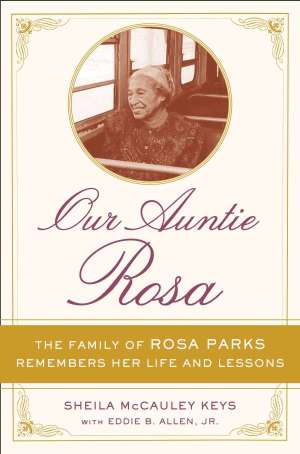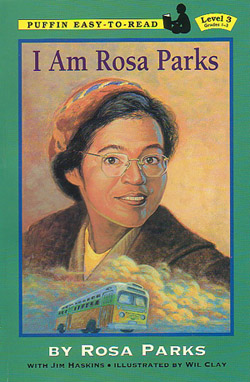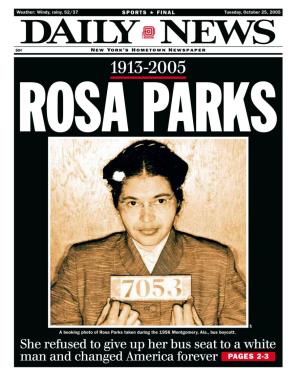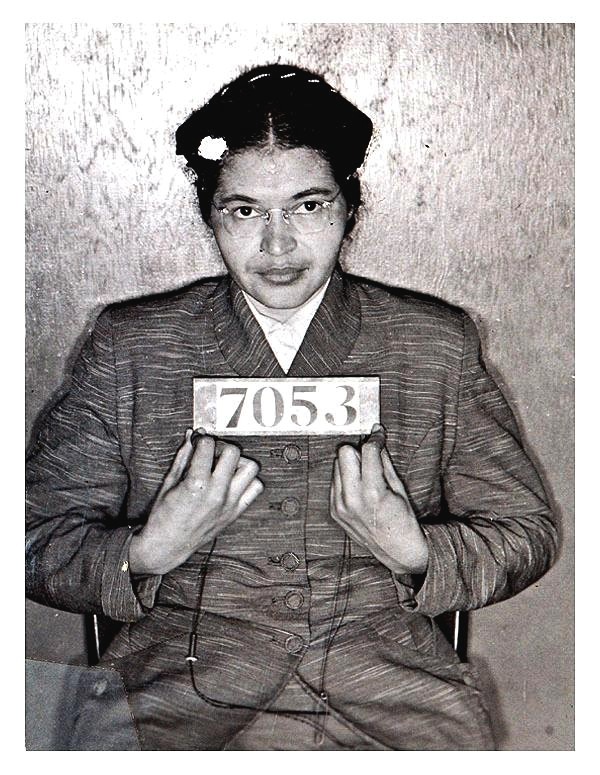 BY SHARNITA MIDGETT Today is the 103rd birthday of Rosa Parks, the woman who taught the world that bus seats are colorblind. The iconic story of her refusal to give up her seat on a bus — back in 1955 in Montgomery, Alabama — so white people could sit down has been taught in American history classes for decades. What hasn’t been told, however, is the story of the woman underneath the icon. A new book called Our Auntie Rosa aims to remedy that. Written by Rosa Parks’ niece and nephew, Sheila McCauley Keys and Eddie B. Allen Jr., the book is an up close and personal look at the woman they called Auntie Rosa. Recently, Phawker was afforded the opportunity to speak with Keys about the book, about who Rosa Parks really was, and the chain reaction that her brave act of defiance set in motion 61 years ago.
BY SHARNITA MIDGETT Today is the 103rd birthday of Rosa Parks, the woman who taught the world that bus seats are colorblind. The iconic story of her refusal to give up her seat on a bus — back in 1955 in Montgomery, Alabama — so white people could sit down has been taught in American history classes for decades. What hasn’t been told, however, is the story of the woman underneath the icon. A new book called Our Auntie Rosa aims to remedy that. Written by Rosa Parks’ niece and nephew, Sheila McCauley Keys and Eddie B. Allen Jr., the book is an up close and personal look at the woman they called Auntie Rosa. Recently, Phawker was afforded the opportunity to speak with Keys about the book, about who Rosa Parks really was, and the chain reaction that her brave act of defiance set in motion 61 years ago.
PHAWKER: When did you realize that Rosa Parks was more than just your aunt, she was a world  famous civil rights icon and a pivotal figure in 20th century American history? Was there an a-ha moment — beyond what your family told you about her — where the full weight of the significance of what she did really hit home?
famous civil rights icon and a pivotal figure in 20th century American history? Was there an a-ha moment — beyond what your family told you about her — where the full weight of the significance of what she did really hit home?
SHEILA MCCAULEY KEYS: I think when I found out who Rosa was was in the fourth grade, because she was always just our relative. She wasn’t Rosa Parks, you know, she was just Auntie Rosa to us. And I did not have an idea in the fourth grade of the ramifications of what this little woman had done back in 1955. Then I found out the woman in the past was my aunt, and I would begin to tell the other school children, they did not believe me, I was making this up, you know. I went home and ask my parents, and they said to me ‘Yes, that Auntie Rosa is Rosa Parks’ and that was the end of that story. Believe it or not, in our family we just did not make a fuss over it.
Auntie Rosa didn’t want us to, and we didn’t. We treated her as our Aunt. We didn’t treat her as the lady that would not move on a bus. Not until I was much older did I even realize how she had changed the world. I didn’t realize, and I think a lot of people today still don’t realize what she’s actually done for them, you know? It’s a worldwide thing, it’s not just for the US. It’s worldwide. That was my a-ha moment I guess, in the fourth grade when I figured it out, “Oh! This is the same person.”
PHAWKER: You say in the book that the story of Rosa Parks bus ride wasn’t told accurately. How does history get it wrong?
SHEILA MCCAULEY KEYS: In the book, my sister Shirley actually asked Auntie Rosa what happened that day, and Auntie Rosa went on to explain how Jim Crow laws prohibited any physical contact or any immediate contact of people of color and white people. So on the bus, there had to be a row of empty space between — they called black people negroes back then — the negro people and the white people. So that’s what she was explaining to my sister, Shirley, is that when she boarded the bus and sat down, it was not crowded, but when a white gentleman got on the bus, the bus driver, who did not like my Aunt — I found out later that he harassed her many times before — he got up and he told my Aunt that she would have to move back because she was too close to the gentleman who sat right in front of her. So there was no row of seats and that was the problem. So she would have to get back. So she said no, she wasn’t going to move. And then he continues to say that he would have her arrested and she says well you may do that, because she knew that it was his right to call the law, the  police. And so he did, he called the police, and that’s how that happened. I think a lot of misinformation a lot of people get about Jim Crow is how it really worked, and how you weren’t supposed to [look white people in the eye], how you were supposed to step off the sidewalk [if a white person was approaching. It was all about people of color to be subservient to the white people. You can’t look a person in the eyes. You may be lynched for that. So those type of rules, it was just crazy. There’s still a lot of problems that we’re having today with that type of hateful rhetoric that is going on in the US and across the world. I would have to say not just the US. And we’re still working on it.
police. And so he did, he called the police, and that’s how that happened. I think a lot of misinformation a lot of people get about Jim Crow is how it really worked, and how you weren’t supposed to [look white people in the eye], how you were supposed to step off the sidewalk [if a white person was approaching. It was all about people of color to be subservient to the white people. You can’t look a person in the eyes. You may be lynched for that. So those type of rules, it was just crazy. There’s still a lot of problems that we’re having today with that type of hateful rhetoric that is going on in the US and across the world. I would have to say not just the US. And we’re still working on it.
PHAWKER: In 1994, Rosa Parks, then 84, was robbed and beaten by a man who broke into her house, leaving with $50. The man who did it was later caught and sent to prison, but somewhere along the way Rosa Parks forgave him. Can you fill in the blanks on the story and explain why she forgave him?
SHEILA MCCAULEY KEYS: My aunt forgave this fellow because she said that he needed help. And my Aunt was not a person who felt that she was above anyone. She was very humble, and she was a person who could walk with kings and queens and then she could also walk and talk with the homeless. She never put herself above not a single solitary soul, and she would always keep that in mind. And I think when this fellow attacked her, even though it was so horrible at that time, she had forgiven him because she said he has problems. He needed to get help for himself, and I do believe she did not want him incarcerated. She wanted him to get help for himself but this is how our society chooses to deal with people that have problems, you know mental problems or whatever problems, we incarcerate them and then think that they will get better but it doesn’t happen.
PHAWKER: What is your take on Black Lives Matter and their methods and the tension between original civil rights activists and today’s generation? What do you think Rosa Parks would have made of Black Lives Matter?
SHEILA MCCAULEY KEYS: I’m sure that Auntie Rosa would agree that black lives matter. Black lives do matter. And I hear a lot of people saying “all lives matter” “police lives matter” “the dog’s lives matter” Well, we’re on the subject of black lives mattering, and that came up because there were so many young people being shot down in the street, and that is where black lives matter came from because it seems as though black lives don’t matter. You can just shoot people down and say, “Oh, I thought they were reaching for something.  Oh I thought, I thought” and so therefore you get to shoot as many people as you’d like, because obviously black lives don’t matter. I think the group was trying to say that yes black lives do matter, and we’re wanting to take a closer look at this, and I think that Auntie Rosa would have wanted to take a closer look.
Oh I thought, I thought” and so therefore you get to shoot as many people as you’d like, because obviously black lives don’t matter. I think the group was trying to say that yes black lives do matter, and we’re wanting to take a closer look at this, and I think that Auntie Rosa would have wanted to take a closer look.
She would have wanted to take a closer look at this because it is happening over and over, and it can’t be a coincidence that it keeps happening. We are not free if we are in fear for our sons and ourselves if we walk outside, that we might not come back home. We might get shot 16 times. That’s not freedom. Nina Simone said that’s what it means to be free — to not to live in fear.
PHAWKER: How far do you think we’ve come as a society since Rosa Parks rode the bus? Are minorities better off today than in Rosa’s day?
SHEILA MCCAULEY KEYS: I think that racism is more of a structural institution now. Back then it was the raw hatred right in your face when my Aunt was trying to make changes, and did make changes. But right now it is such a finely tuned instrument that you hardly know it’s happening, but it is. And then to try to make the changes to the institutions it is very difficult to get everyone on the same page, some people seriously believe that the police [have a right to] shoot you 16 times.
Agree or disagree, that’s right in your face. But when it’s a structural thing when you’re kept out of certain jobs, certain housing markets, it’s that structure. I believe it’s by design. I don’t believe that it’s just a fluke, that it just happens. Nothing just happens. My Aunt used to say we’ve come a long way but we have so much more work to be done, and this is the truth. We have a lot to do.

